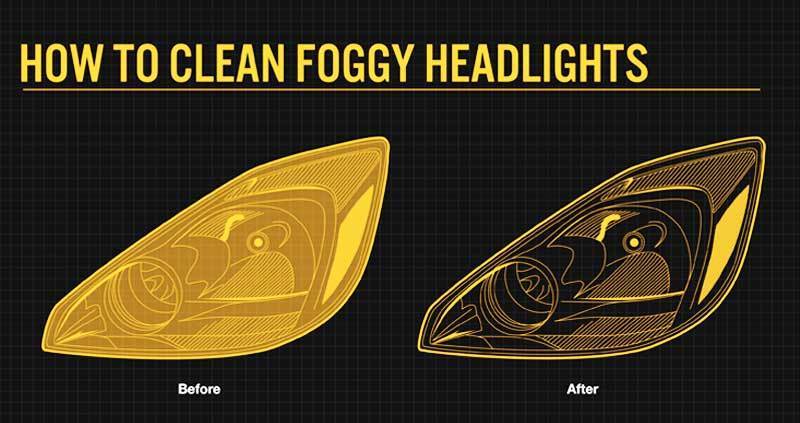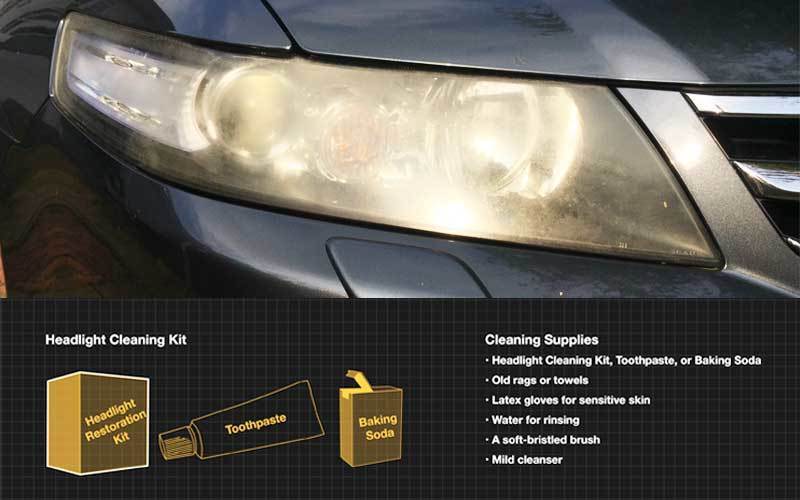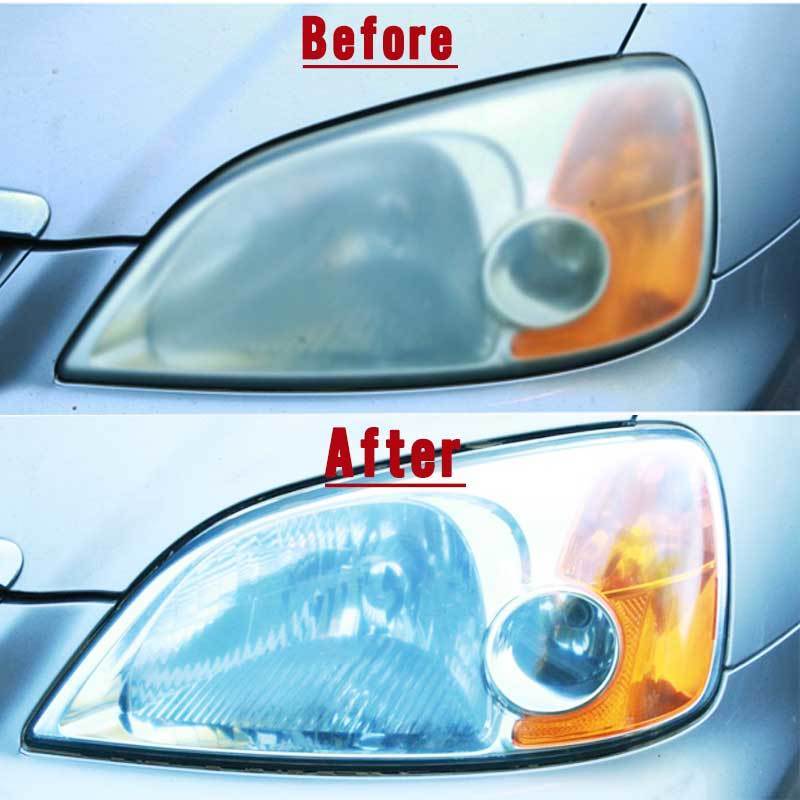When driving at night it usually gets hard for people to see the road. Even with the car headlights on, you still can’t see the road. This may be due to the atmospheric conditions around.
It can happen that the sun, rains, dust, and other road conditions may have taken a toll on them. In these cases, the headlights turn foggy. And foggy headlights are translucent, that is they block almost 50% of the light flow, and this is very risky.

Now, why do the headlights turn foggy?
The headlights are external fixtures, and that makes them easily available for any kind of atmospheric assault.
Most of the LED headlights today come covered in a top coat of some chemical that avoids the easy wear and tear of the headlights. But because of the atmospheric conditions, like the rains, temperature, and many other factors cause damage to this upper coat first, and then the headlights. Here are some common reasons why the headlights turn foggy.
In some cases the reason might be oxidation.
The headlights installed in cars are acrylic headlights. Now, these headlights come with a thin top layer, the clear top coat to prevent any damage. But due to exposure to UV light, this top coat wears off and oxidizes. The oxidation takes place because the polycarbonate lens gets exposed to the air. The lens can also develop cracks if it is exposed to UV radiation.
As you go along the road, there is a lot of debris that gets into the headlights. Some pieces of gravel, road salt, and many other such particles are hit on the headlights as one drives on the road.
These elements cause the wearing off of the top coat on the headlights. It also creates pits and scratches on them, thus adding to their cloudy appearance. Thus, road damage can also turn the headlights foggy.
Now, of all the parts of the car, headlights are one of those parts that are taken for granted, usually. Being such a small thing, they are usually ignored. But as the long running years of the car damage other parts like the clutch or the accelerator, headlights also get damaged to some extent.
Over the years, the dirt and the chemicals from the atmosphere damage the top coat on headlights and turn them foggy. Moreover, these chemicals also form a thin layer on the headlights and dim the light or make it hard to see on the road.
When manufactured, headlights have a water tight seal on them. But excessive use of the car can cause its wear and tear. And in some cases, it may also break the water tight seal.
Now, because you can’t wipe it away, there is condensation formed inside the lens. And these water droplets scatter the beam of light. This is a safety hazard, as it impairs night time visibility.
Now, why are foggy headlights are of such a big concern?
People generally don’t realize headlight damage. Especially during the summer time, because the day light hours are longer and people who live in a dry climate may not easily notice the problem. But foggy headlights affect the light output. The beam of light is prevented its full ground coverage and it becomes a serious problem in the winters, where the daylight hours are lesser, and the nights are darker.
So, before the headlights turn completely foggy and cloudy and cause any accidents, here are some very easy ways in which you can prevent this from happening:
- Make sure to park your cars in the shade, if you have easy access to it, or park it in a garage. If that option is ruled out, park your car in such a way, that the headlights are away from the sun. This will prevent the direct contact of the headlights from the sun and it will keep the top clear coat from wearing off, thus preventing cloudy headlights. Also, exposure to sunlight for a long time makes the glass weak.
- Keep your cars clean. Wash your cars every three months. Make sure you clean your headlights with automotive soaps. With this, you can ensure that the chemicals or any kind of dust accumulated on the headlights are washed off. This will thus prevent the oxidation of the headlights, hence keeping them from turning foggy. See for any cracks in the headlights, and if there are any, consider changing the headlights. The cracks allow the air and moisture to go in and cause condensation, thus just speeding up the fogginess of the headlights.
- You can also polish the headlights after certain time intervals. You can use a non-abrasive polishing medium and a soft cloth to clean the headlight lenses and also prevent the early signs of headlight yellowing.
But if it is too late, the headlights have already turned foggy, don’t worry, here are some DIY ways you can clean those foggy headlights.

How to clean foggy headlights with vinegar?
Out of many other ways, cleaning foggy headlights with vinegar is the most trusted and easy do the procedure. Follow these simple steps and get rid of those foggy headlights with ease.
Things you will need:
- Vinegar.
- Paper towel.
- Water in a spray bottle.
- Microfiber cloth or rag.
- Baking soda, 1-2 tablespoons.
- Liquid soap.
- Clean dusting cloth.
- Headlight Restoration Kit
Step 1: Remove the dust
First, you have to remove the dry dust from the headlight with a clean dusting cloth. Make sure you use a soft clean cloth while cleaning the headlights to avoid scratches.
Step 2: Mix liquid soap with water to dilute the solution
Get some liquid soap in a bowl and dilute it with water. Mix it till you get a thin solution. If possible, mix the liquid soap in warm water. After applying the solution on headlights, let it sit for some time and clean it with a soft or a microfiber cloth.
Step 3: Clean the headlights with the solution
Clean the headlights with the diluted soap solution. Try and clean off as much dirt as you can and then rinse off the solution. Before getting the vinegar in action, make sure you have cleaned off most of the surface dust with the soap itself. That way, the difficult parts of cleaning are left to the vinegar.
Step 4: Make another solution consisting of baking soda and vinegar
In another bowl, prepare a paste using baking soda and vinegar. Make a thick paste and use white vinegar.
Step 5: Clean the headlight with the baking soda and vinegar solution
Now clean the headlight with this solution. Clean the grime neatly, let the solution sit for some time. Then wash off the solution with water. And in the end, wipe it off with a dry paper towel.
And there you have clean, fog-free headlights. Cleaning foggy headlights with vinegar is the most common and easy ways to get rid of them. Also to top that, it is an easy household remedy that you can do. So next time your headlights get foggy, you need not go to a mechanic to fix this. You can do it on your own.
Most cars these days come with plastic headlights. Plastic headlights are in many ways durable rather than glass or acrylic. But at the same time, they can also get dirty easily.
So here are some tried and tested ways to clean plastic headlights in the household, you can use the following items to have it clean.

How to clean plastic headlights in the household?
Dish Soap:
Clean the plastic headlights with dish soap. Before you start applying dish soap, clean the headlights with a dry dusting cloth first. Later, use a sponge or a microfiber cloth to clean the headlights and the tail lights.
Baking Soda:
Mix some baking soda in warm water and apply it to the headlights and tail lights. Polish the headlights with a clean cloth after. The baking soda acts as a buffering agent, it soaks up the oxides.
Bug Spray:
They go to remedy to clean cloudy headlights is by using a bug spray. Apply some of it on a soft cloth and clean the headlights. The chemicals in the bug spray remove some of the dirt-damaged and UV-damaged plastic from the headlights. This results in a cleaner and shinier appearance.
Toothpaste:
Another easy and go to remedy to clean plastic headlights is toothpaste. It may turn heads, but it sure works wonders. Take some toothpaste, squeeze it directly on the headlights, and make sure to use a soft cloth to clean it. Wipe it away and you have cleaner and less foggy headlights.
Salt and Dish Soap:
In a bowl, mix some dish soap, salt, and warm water. The salt in the mixture gives it an abrasive texture, hence making the cleaning easier.
These were some of the ways to clean plastic headlights with household items.
So, the next time you think of cleaning your car, make sure you keep in mind the headlights. Make sure you clean your headlights thoroughly. Use the household remedies to clean them. Also, don’t let your headlights get foggy. And if you see that they are foggy, clean them on time to avoid any further consequences. Prevent in all the ways you can, the fogging of headlights before it causes any dangerous issue.

